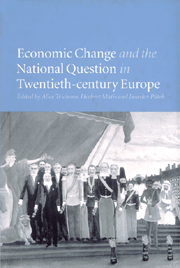Book contents
- Frontmatter
- Contents
- List of figures
- List of tables
- Notes on contributors
- Acknowledgements
- Introduction
- 1 Nationalism and the economic question in twentieth-century Ireland
- 2 Economic aspects of the nationality problem in nineteenth- and twentieth-century Belgium
- 3 The economy as a pushing or retarding force in the development of the German question during the second half of the twentieth century
- 4 Lusatian Sorbs in Germany before the Second World War: the influence of the economy on the national question
- 5 Unequal regional development in Switzerland: a question of nationality?
- 6 The Portuguese national question in the twentieth century: from Spanish threat to European bliss
- 7 From autarky to the European Union: nationalist economic policies in twentieth-century Spain
- 8 The economic background to the Basque question in Spain
- 9 Economic change and nationalism in Italy in the twentieth century
- 10 National integration and economic change in Greece during the twentieth century
- 11 National identity and economic conditions in twentieth-century Austria
- 12 Economic, social and political aspects of multinational interwar Czechoslovakia
- 13 Nationality and competition: Czechs and Germans in the economy of the First Czechoslovak Republic (1918–1938)
- 14 Economic aspects of Slovak national development in the twentieth century
- 15 Economic change and national minorities: Hungary in the twentieth century
- 16 Economic background to national conflicts in Yugoslavia
- 17 Economic differentiation and the national question in Poland in the twentieth century
- 18 Economy and ethnicity in the hands of the state: economic change and the national question in twentieth-century Estonia
- 19 Changing structure and organisation of foreign trade in Finland after Russian rule
- 20 Economic change and the national question in twentieth–century USSR/Russia: the enterprise level
- Index
16 - Economic background to national conflicts in Yugoslavia
Published online by Cambridge University Press: 01 September 2009
- Frontmatter
- Contents
- List of figures
- List of tables
- Notes on contributors
- Acknowledgements
- Introduction
- 1 Nationalism and the economic question in twentieth-century Ireland
- 2 Economic aspects of the nationality problem in nineteenth- and twentieth-century Belgium
- 3 The economy as a pushing or retarding force in the development of the German question during the second half of the twentieth century
- 4 Lusatian Sorbs in Germany before the Second World War: the influence of the economy on the national question
- 5 Unequal regional development in Switzerland: a question of nationality?
- 6 The Portuguese national question in the twentieth century: from Spanish threat to European bliss
- 7 From autarky to the European Union: nationalist economic policies in twentieth-century Spain
- 8 The economic background to the Basque question in Spain
- 9 Economic change and nationalism in Italy in the twentieth century
- 10 National integration and economic change in Greece during the twentieth century
- 11 National identity and economic conditions in twentieth-century Austria
- 12 Economic, social and political aspects of multinational interwar Czechoslovakia
- 13 Nationality and competition: Czechs and Germans in the economy of the First Czechoslovak Republic (1918–1938)
- 14 Economic aspects of Slovak national development in the twentieth century
- 15 Economic change and national minorities: Hungary in the twentieth century
- 16 Economic background to national conflicts in Yugoslavia
- 17 Economic differentiation and the national question in Poland in the twentieth century
- 18 Economy and ethnicity in the hands of the state: economic change and the national question in twentieth-century Estonia
- 19 Changing structure and organisation of foreign trade in Finland after Russian rule
- 20 Economic change and the national question in twentieth–century USSR/Russia: the enterprise level
- Index
Summary
INTRODUCTION
Yugoslavia (1918–91) was a conglomerate of several different ethnic groups (table 16.1), two alphabets, three major religions, five languages, it was known for large socio-economic disparities and inequalities and a unique state system. It has threaded the way from a unitary state (1918–41), often accused of being just a hegemony of one nation over the others, to the state of eight federal units (1945–91). After the break-up of Yugoslavia in the 1990s, four of them, namely Slovenia, Croatia, Bosnia-Herzegovina and Macedonia, became internationally recognised independent states, whilst the remaining four (Serbia, Vojvodina, Kosovo and Montenegro) are at the time of writing united under one state, which has, quite unjustifiably, retained the name Yugoslavia. Figure 16.1 reveals one of the most important characteristics of the former Yugoslavia: the further south-east one goes from the north-western part of the country, the smaller is the national homogeneity of the former federal units; in Slovenia 90.5 per cent of the population were Slovenians, in Croatia 75 per cent of the population were Croats, in Serbia 66.4 per cent of the population were Serbs (including Vojvodina and Kosovo), in Macedonia 67 per cent of the population were Macedonians and in Montenegro 68.5 per cent of the population were Montenegrins. Muslims were the most numerous nation in Bosnia-Herzegovina, accounting for 39.5 per cent of the total population. Serbs represented the second most numerous segment of population – 32 per cent – and Croats were the third, representing 18.4 per cent of total population.
- Type
- Chapter
- Information
- Publisher: Cambridge University PressPrint publication year: 2000

